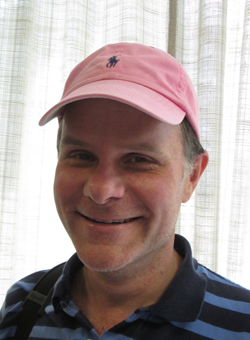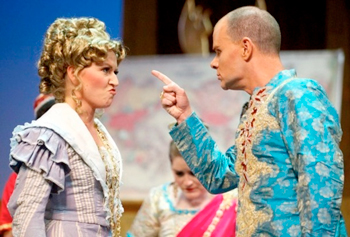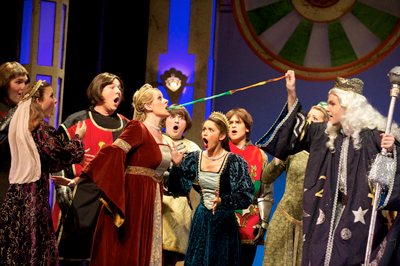by Kelly Ferjutz, Special to ClevelandClassical
 Steven Daigle (left) has been at the helm of Ohio Light Opera since 1999. But not even a Superman could successfully choose and direct all seven full-scale productions in the eight-week summer season at The College of Wooster. This season, Daigle will be in charge of four of the seven shows, and three members of his company will each direct one.
Steven Daigle (left) has been at the helm of Ohio Light Opera since 1999. But not even a Superman could successfully choose and direct all seven full-scale productions in the eight-week summer season at The College of Wooster. This season, Daigle will be in charge of four of the seven shows, and three members of his company will each direct one.
I sat down with Daigle, associate director Julie Wright Costa, principal guest director Ted Christopher, and Jacob Allen — all four of whom are teachers specializing in the lyric theater tradition — to ask questions about their careers and their lives at OLO.
Kelly Ferjutz: Could you each share your thoughts about shows you’re directing this season?
Steven Daigle: I’m directing four of the seven productions. Our repertory is shifting in the direction of a musical theater, which has a different emphasis than operetta. They all have their difficulties, but the biggest one is time constraints — there’s a lot to do after choosing a piece before you present it to the audience. Building sets is time-consuming and expensive. We’re trying to economize where possible, without hurting our quality. Maybe we build less complex sets at times.
We have to establish objectives and then be able to live up to them. The expectation of accessibility is different in musical theater than that of operetta, and it’s essential to keep the show moving. For instance, operetta might have three acts, each of which will generally have one set or location overall. (Some have more, of course.) Musical theater, on the other hand might have 5-7 sets per act! This means delays in changing sets, etc. One scene change in One Touch of Venus, for instance, requires 16 cast members to execute it properly! They have to be really careful while still maintaining a degree of speed. It’s called ‘Keep the show moving!’
Styles of theatre and the necessary pacing are a delicate balance. You need to be aware of the history of the performances and the history of your current performers. It’s complicated when you have to double-cast a show for whatever reasons. You sometimes have the singers all on stage at the same time, or maybe alternating in rehearsals. I chart everything out, so I know where we are.
Directing two musicals back-to-back is daunting. Can-Can is totally different from One Touch of Venus. And this year I’m directing Ruddigore for the very first time. It’s the last in the G&S canon for me.
Julie Wright Costa: This year we’re doing my two absolute favorites by Gilbert & Sullivan: Ruddigore and Yeoman of the Guard. Ruddigore is just raucous fun, but Yeoman is my very fave. It has an incredible story with such a bittersweet ending that’s almost unresolved. I’ve directed it one other time, but I have appeared in it four times. I’m fortunate to have Ted appearing as Jack Point, the jester in Yeoman, and I’m really looking forward to putting my director’s vision on stage.
Ted Christopher: Oh! Kay is very much like a 1930s screwball film — a drawing room comedy with a Busby Berkley chorus in the middle of it. There is a lot of singing and dancing, but what else would you expect from the Gershwins? Most of the time, the dancers and chorus don’t interact much with the principals. An informed choreographer is essential to making the company of mostly non-dancers move well on stage. They need to ‘feel pretty’ in the lingo of the theater. Our choreographer, Carol Hageman, makes it fun to direct this type of show here. And — the orchestra! We have a full orchestra for our productions, which doesn’t happen everywhere. It’s an integral part of our mission.
KF: What’s the hardest thing about being a director?
JWC: Being both an actor and director in the same play! The director needs to be focused on everything! Steve helped me to know when to put on my director’s hat.
Jacob Allen: Time constraints. The schedule has to be really tight to do all of this, and sometimes there’s no room to breathe.
SD: We do rolling repertory here, which is different from producing just one play at a time. It’s a whole other emphasis, especially with the time constraints that are built in to it. Deadlines are always right there! Problem-solving skills are especially needed in this situation. You have to be able to think on your feet.
TC: Getting out of your comfort zone! But that’s what helps you grow, so it’s essential, in my view.
JA: Serving the piece. You have to have an open mind to get to the right solution. Directing at OLO has a learning curve that may be steeper in some ways than other theaters. We do a greater variety of styles than any other company I know of — European operetta, Gilbert & Sullivan, and American musicals that are very sophisticated. OLO produces everything!
KF: Have you ever had a temper tantrum? Ever wanted to?
JRC: Yes. In a company of this nature, we have older, more experienced people on the same stage as well as comparative newcomers. The biggest hurdle is the newcomers’ lack of preparation, even though everyone gets abundant advance materials – tapes, linguistic help, etc.
JA: Yes! But like in rowing, no matter how hard the coxwain yells at the team, it doesn’t make the boat go faster. It’s tempting to yell if someone is hindering the process. I’ve outgrown those tantrums!
KF: Have you ever worried that your acting or singing talent might abandon you?
JWC: Not excessively, although I’ve been here for 24 years! I started as an ingénue, and gradually moved up to leading lady roles, and now while I’m still doing some of them, I’ve also shifted to character roles. There are some shows in which I’ve played all three categories! But then, too, when I realized I wasn’t the best choice to continue as an ingénue, I wondered ‘what will I do here?’ Then Steve advised me to get into directing. It adds to my teaching side, so not only was it not at all fearful, but it also helped me to adapt, and I can also pass along my love of stagecraft. It became a very natural progression, adding to my own education. In addition to directing, character roles are a new way to grow here.
KF: Have you ever agreed to direct one show, and then later wished you’d made a different choice?
TC: Usually I direct opera, so lyric theater is a new venture for me. The big Broadway shows are not my metier at all. Student Prince was more my thing, but OLO gets you out of your comfort zone.
KF: What does becoming a director do to your personal lives?
JA: Unless you’re in your own hometown, you’re always an itinerant worker. Your family needs to be incredibly understanding.
TC: I’m fortunate that my family can be here with me. It also helps that I’m from the Northeast Ohio area.
SD: Now that my daughter is older, my family spends some of the summer here with me.
KF: Have you ever had a major conflict with any tech staff? Who wins in that case?
TC: The director wins. But when everyone is on board, everyone wins. That’s the great advantage of repertory. Everyone is here, all the time. They get to know each other, and it shows in the finished product. There’s an element of trust that takes it to the next level.
KF: Do you ever cut or rewrite anything?
SD: No. We may occasionally have to cut a piece of a song, but it might then end up elsewhere in the production. We do them pretty much complete. After all, for Gilbert and Sullivan and Broadway musicals, both words and music are ‘off-limits’ to adjustments. Therefore the language and the behavior of the characters must remain as they were created in the first place.
KF: How do professional productions advance the art of lyrical theater?
SD: If you’ve ever only seen a community theater or high school presentation, you might be hard-pressed to recognize the same show as we will do it. With professional tech people and trained, more mature performers, wonderfully appropriate costumes, and a full orchestra, there is really no comparison. That is not to put down those other performances, which are essential to keeping this genre alive. But professional wins every time.
For ticket information, visit the Ohio Light Opera website or call the box office at 330.263.2345. Wooster is about 75 miles southwest of Cleveland, and easily accessible by I-71. (If you plan to take 585 south from Route 21, be advised that portions of it are closed, but detours are clearly marked.)
Click here to read more about this season’s shows and listen to sound clips.
Headshots by the author.
Published on ClevelandClassical.com June 16, 2015.
Click here for a printable copy of this article










